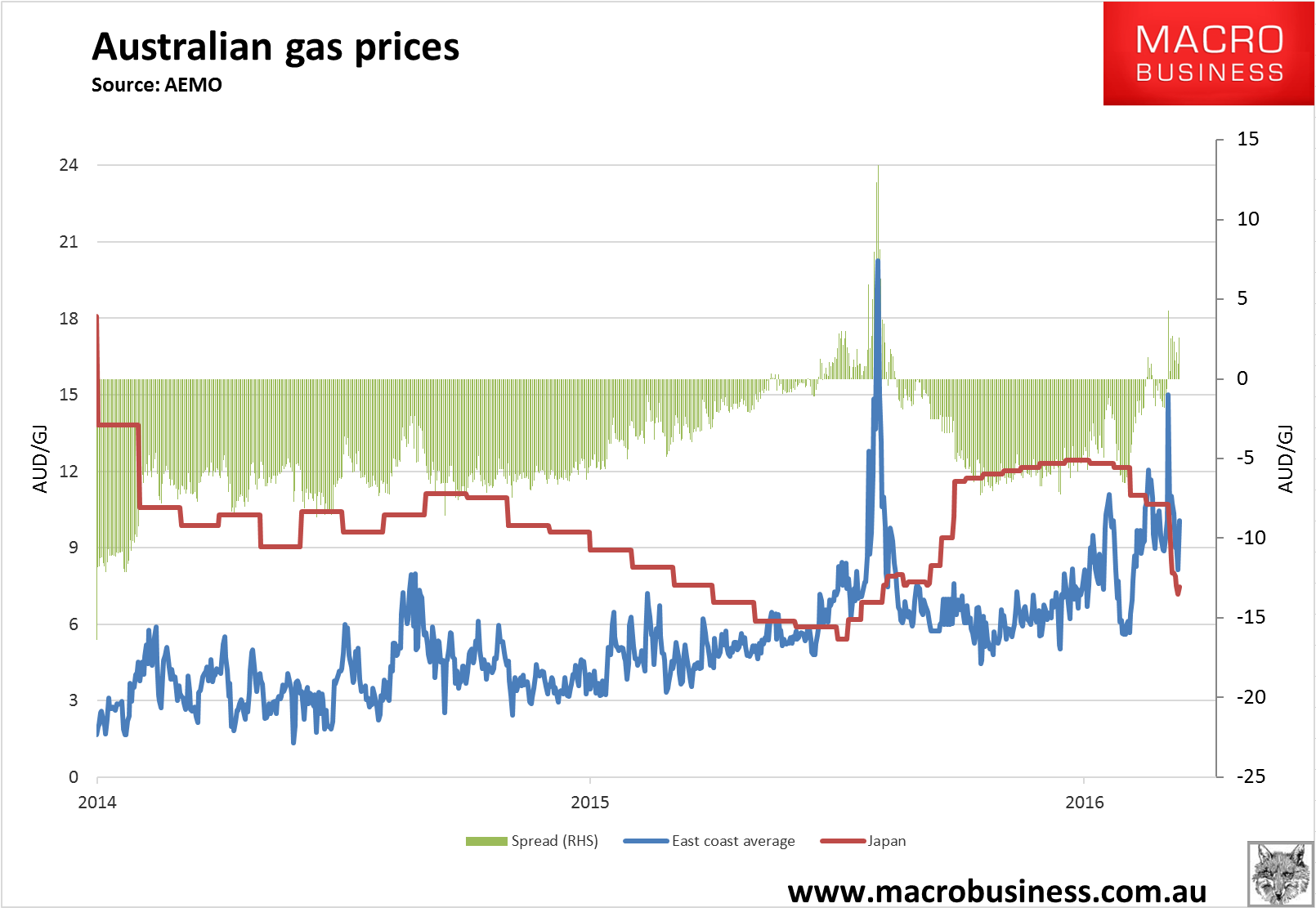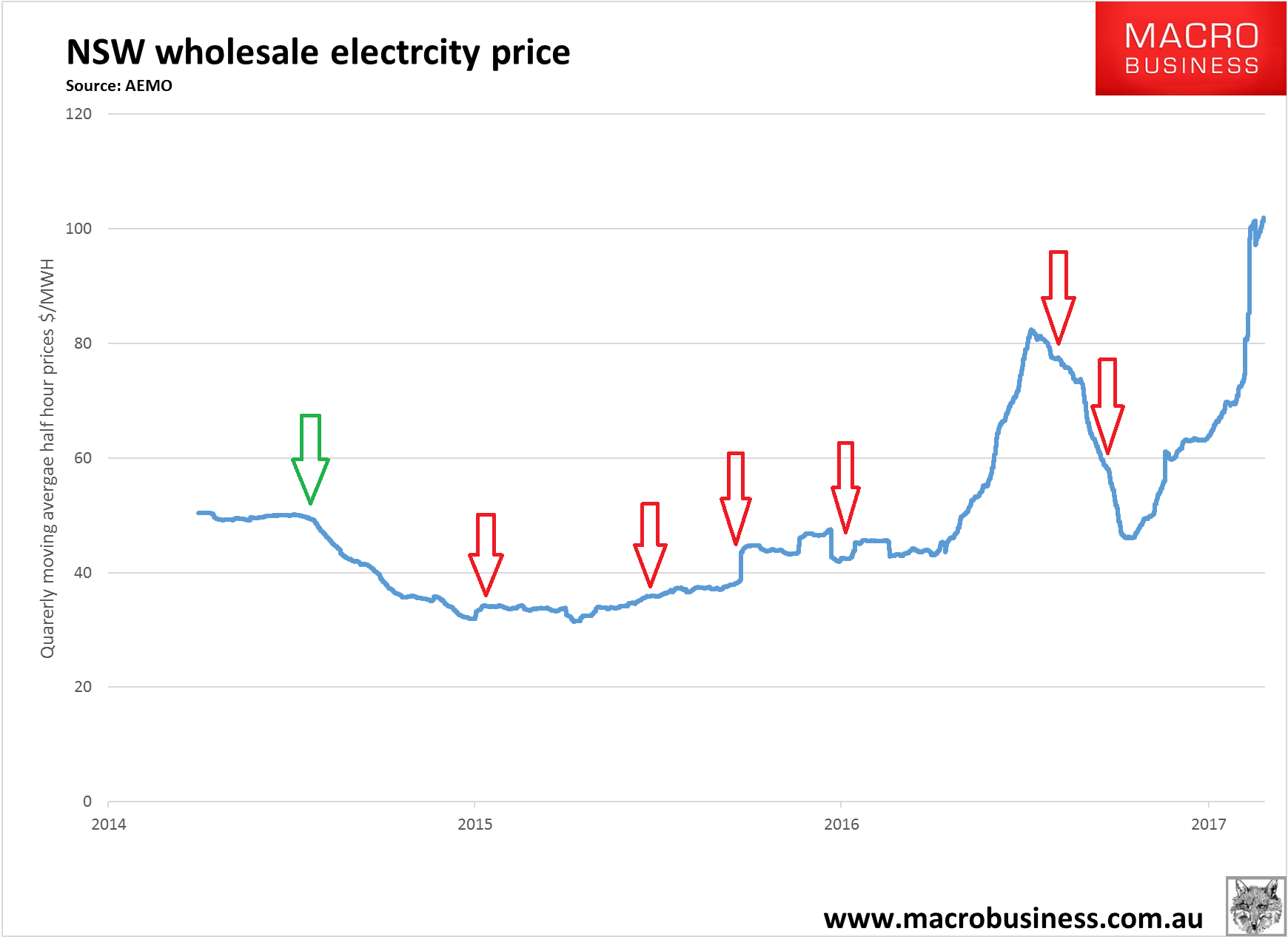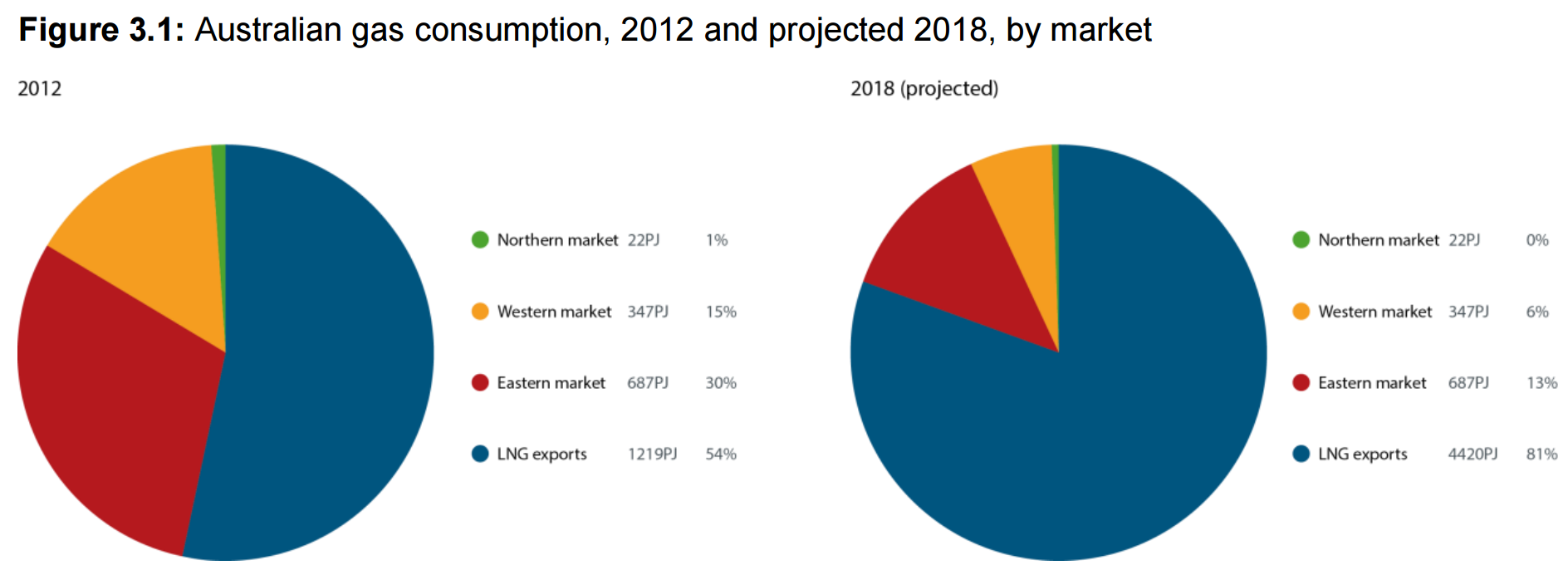The energy market remains in disarray today as local prices surge while Japanese prices for the same gas remain $2.60Gj lower:

Nick Xenophon has managed to put a few sensible ideas on the agenda to address the issue:
“The government foreshadowed last election it would construct a solar thermal plant in South Australia. This has now been elevated as a key government policy,” Senator Xenophon said outside a small Canberra convenience store at the weekend as he portrayed the company tax cuts as a boon for small businesses.
While the one-off “energy transition” payment to pensioners was the only new policy suggested by Senator Xenophon and adopted by the government in order pass its company tax cuts, a further 12 existing government plans were fast-tracked by up to two years and thrown into the package to keep the Nick Xenophon Team crossbenchers on side.
The federal government agreed to potentially accelerate the development of a $1 billion gas pipeline from the Northern Territory to South Australia and a South Australian solar power plant in order to secure NXT support.
…there are no guarantees the pipeline will go ahead because the territory government would have to lift its current moratorium on further gas development.
The rest of the electricity “affordability and reliability” package comprises a number of reviews including a commitment to “implement” policies arising from the Finkel review and to overhaul the National Energy Market by July 2018, a year after the final recommendations are due to be released.
By July 1, 2017, the government must put in place a new regime to make pricing by gas suppliers and pipeline operators more transparent.
There’s also a review of the “use it or lose it” test for undeveloped gas titles held by companies, and a Productivity Commission review of the joint marketing arrangements of energy companies.
However, note the SA focus. Any NT pipeline will be very expensive and is unlikely to shift enough gas to make a difference. It’s not just the fraccing ban, the current NEGI proposal has questionable economics and will only deliver 40Gj of gas versus an east coast shortage of 160-200Gj and at very high prices.
Meanwhile, Victoria’s Opposition wants to go coal:
Victorian Liberal leader Matthew Guy has pledged the party would keep brown-coal-fired stations fuelling the state’s energy needs, declaring that he would not allow any more power plants in the Latrobe Valley to close if the Coalition won government.
Mr Guy told party faithful yesterday that last week’s closure of the Hazelwood brown-coal power plant was a “dark day in our state’s history”. He said he would ensure the Loy Yang and Yallourn power stations would continue burning brown coal if he became premier.
“I will not allow our coal resources to be wasted, I will not allow such economic advantages to Victoria to be kept in the ground for the sake of ideology. We should be powering our state through the 21st century,” Mr Guy said at the Liberal Party’s state council.
But the party still backs the government on a moratorium on conventional gas exploration until 2020, a policy Malcolm Turnbull has labelled “reckless”.
Not reckless, obsolete. Victoria has NO onshore gas reserves.
As you can see from the above, the failure to co-ordinate energy policy at the federal level with national policy for a functional gas market and electricity transformation is threatening to rip up energy markets in a madly partisan state scab grab. It’s plainly obvious what is needed. A national policy to get gas flowing and national policy to price carbon.
Judith Sloan had a go at some national policies on the weekend:
This week we learned that the complete power blackout that occurred in South Australia last September was due to the existence of a large number of wind farms that simply ceased to operate in the context of a strong storm, in turn causing the interconnector with Victoria to trip.
I’m not sure why anyone would be surprised to read this conclusion. The way our electricity system has been allowed to develop — a thin grid with poor interconnection and a concentration of intermittent generation at the end of the grid — meant this was an accident waiting to happen.
The rejigging of the wind farms to reduce the likelihood of them shutting down when the wind is blowing strongly will help a little.
But there is little that can be done when the wind doesn’t blow, which was the case when load-shedding affected 90,000 households in SA in February. Intermittent energy is just that — it can’t be relied on.
We also learned this week that Alinta Energy had offered to keep the coal-fired Northern Power Station operating until next year in exchange for a $25 million grant from the SA government.
Had that power station been in operation, neither the blackout nor the load-shedding would have occurred.
But to brag about its climate credentials, the SA government rejected the Alinta offer, claiming that its support for renewable energy would not only see the state through but it also would underpin economic prosperity and jobs growth.
Sadly, SA has enjoyed neither economic prosperity nor jobs growth, but the taxpayers will now bear the burden of a $550m bill to build a lightly used gas-fired power station, a big battery that will power the state for a few minutes, and a bank of diesel powered generators, just in case things turn really pear-shaped.
Not surprisingly, members of the federal government — particularly Malcolm Turnbull and Environment and Energy Minister Josh Frydenberg — have been making political points by bagging the SA government. But here’s the thing: the federal government is much better at bagging than fixing.
…What the government urgently needs to consider is freezing the RET at its present level, plus some allowance for projects in the pipeline, and converting the target to a clean energy target in which different sources of electricity generation are weighted according to their emissions intensity.
In this way, there is every likelihood that some new gas-fired electricity generation could come on stream and some existing gas plants could be pulled out of mothballs. There also would be an incentive for the continuation of some existing coal-fired power stations.
…As for the supply of gas, there may be a case for the building of a new coal-fired power station in Gladstone that would power the liquefaction of the gas, thus releasing more gas for domestic purposes. Small operators also may be able to scoop up the puddles of gas that still exist in the Bass Strait.
The time for action is now, not in four or five years. Storage could play a bigger role down the track, but the problems of the electricity system and the shortage of domestic gas are with us now and can’t wait for longer-term solutions. If Canberra does not come up with short-term practical solutions — not the pretend ones it has proposed thus far — the electorate may well conclude that the federal government is no better than the SA government when it comes to energy policy.
As readers know, MB is all for fixing it in a hurry. But rejigging rules to boost gas consumption when the key driver of the crisis is a shortage of gas sure doesn’t make any sense. By all means do what can be done to release the supply of gas but publicly subsiding intrinsically stranded assets is hardly the way to do it. It won’t be enough and still leaves the gas cartel in place wrecking manufacturing at no profit to anyone. Moreover, states will continue to operate like sovereigns.
If government intervention in the energy market is warranted, as Sloan clearly argues that it is, then let’s cut the bullshit and go straight to the source of the problem. The best way to boost gas power supply, of which there is oodles sitting idle and more could be very easily be built, is to address the soaring cost of gas which is retarding its use.
We have enormous amounts of gas supply. The problem is the Curtis Island LNG export monster that is sucking it up in a way that it never said it would. Here’s the chart (the green arrow is the carbon price abolition, red is Curtis Island LNG startups):

All we need to do is keep a little of it for ourselves, just 3.6% of exports in fact, and the entire energy crisis will disappear:

We need cheaper gas and stable carbon pricing policy. Then all of the problems will go away at once and we’ll have time to decarbonise the network with longer term battery and other storage options to stabilise renewables. This was always the national plan, such as it was, that gas would be the transitional fuel as we move steadily from coal power to renewables. The only thing that has gone wrong with it is an east coast gas cartel has formed around Curtis Island and is gouging the shit out of everyone.
Third party gas exports need to be banned, domestic reservation installed and “use it or lose it” rules applied. But don’t trust me, trust the best, Credit Suisse:
■ Our preferred option is to reclaim the third-party gas currently being exported: Aside from the Horizon contract between GLNG and Santos, there was no evidence in the EIS or FID presentations that more non-indigenous gas was required. As such, one could argue reclaiming what has only been signed due to a scope failure, is equitable. Including the Horizon contract GLNG will be exporting >160PJa of third-party gas in the later part of this decade. Whilst we get less disclosure these days, BG previously said that after an initial 10–20% in the early days (now gone) QCLNG would use ~5%
■ Our preferred option is to reclaim the third-party gas currently being exported: Aside from the Horizon contract between GLNG and Santos, there was no evidence in the EIS or FID presentations that more non-indigenous gas was required. As such, one could argue reclaiming what has only been signed due to a scope failure, is equitable. Including the Horizon contract GLNG will be exporting >160PJa of third-party gas in the later part of this decade. Whilst we get less disclosure these days, BG previously said that after an initial 10–20% in the early days (now gone) QCLNG would use ~5% thirdparty gas – 20–25PJa. APLNG is self-sufficient, but as can be seen the other thirdparty gas would get extremely close to balancing the market. Clearly these things are far better done by mutual agreement from all parties, rather than a political mandate.
■ GLNG loses but can all be compensated? We estimate that, at a US$65/bbl oil price, GLNG as an entity would lose US$447m p.a. of FCF if they could no longer toll thirdparty volumes. Interestingly, if Kogas and Petronas could recontract their offtake on a slope of 12x (doable in the current LNG market) then their losses as an equity partner are all offset (not equally between the two albeit). Santos would see ~50% of its US$134mn net GLNG loss offset if the Horizon contract could move up to a slope of 8x from 6x. The clear loser would be Total. We wonder whether cheap government debt, a la NAIF, could be provided at the (new, lower volume) project level or even to take/fund an equity stake in it? In reality all parties (domestic buyers included) have some culpability in the situation, so a sharing of pain does not seem unreasonable 02 March 2017 Australia and NZ Market daily 31.
If you want public intervention then get behind that, Judith.

